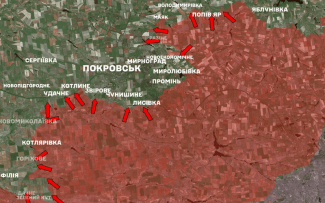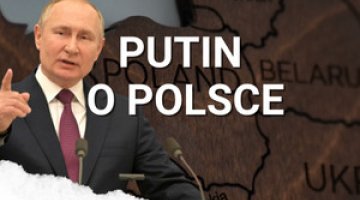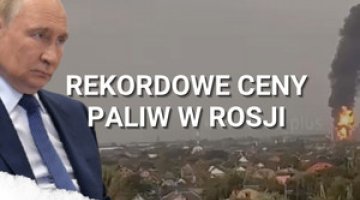Pokrovsk conurbation in a pocket. Day 1252 of the war

![]()
The Russians have significantly deepened and widened the breach to the north and west of the Pokrovsk–Kostiantynivka road, meaning the entire Pokrovsk conurbation is now in a pocket. Russia is less than 5 km away from both the main Ukrainian supply routes in the north and west, which greatly complicates logistics. While the Russians periodically suspended their advance towards the road from Pokrovsk to the Dnipro after the Ukrainians moved it from the west to the north (operations in this direction have resumed in recent weeks), they continue to advance towards the road to Kramatorsk, from which they are separated by one village – Rodynske. The defenders still have a local road, but it does not have the capacity to sustain a long-term, organised defence and is also threatened by enemy action (the Russians are 7 km south of it).
As the encirclement of the Pokrovsk conurbation progressed, Russia approached the borders of Pokrovsk and Myrnohrad from the south, and further Russian sabotage-reconnaissance groups are infiltrating both cities. After capturing Novoekonomichne (25 July), they also gained the opportunity to enter Myrnohrad from the north-east. It remains an open question whether the Ukrainian command will be able to muster the forces and resources to attempt a counterattack and thus clear the supply lines of the defenders of the conurbation, or whether – if unable to gather them or if the counterattack fails – they decide to withdraw from Pokrovsk and Myrnohrad, which no longer have much military significance (Pokrovsk lost its status as the main logistics hub of the Ukrainian forces west of Donetsk last autumn). Kyiv’s decision to hold on to the conurbation without first unblocking it risks a repeat of the fighting for Bakhmut in recent weeks, which saw a rapid increase in losses on the Ukrainian side.
Russian forces are systematically pushing Ukraine out of its last positions in Donetsk Oblast between Pokrovsk and Velyka Novosilka. Four villages near the border with Dnipropetrovsk Oblast in three different locations remain under Ukrainian control. The Russians crossed the border of Dnipropetrovsk Oblast in another place (according to some sources, they captured the village of Maliivka) and also Zaporizhzhia Oblast (Temyrivka reportedly fell under Russian control). In the latter, they took control of Kamianske on the Dnipro river and continued their advance north along the road to Zaporizhzhia, where Stepnoye is the main element of the next Ukrainian line of defence.
Ukrainian troops withdrew from the salient west of Toretsk, where they had held the village of Shcherbynivka, thus preventing Russian forces from taking full control of the city. However, Russian advances on the flanks towards Kostiantynivka threatened to cut off the Ukrainians there from the rest of their forces. Ukraine is now only holding on to the north-western outskirts of Toretsk. After several weeks of fighting, the Russians have captured Yablunivka, which opens the way for them to Kostiantynivka from the south-west.
The Russians carried out an offensive towards Siversk, using armoured and mechanised columns for the first time in several months. Most likely, its purpose was to reconnoitre the situation in one of the most difficult sections of the front for the invaders (due to extensive Ukrainian defences) and, at the same time, one of the most stable sections. The Russians were undoubtedly encouraged to organise this operation by the progress made in previous weeks north-east of Siversk, indicating a gradual weakening of the defences. After the Ukrainians quickly detected the grouping, one column continued its advance. According to some sources, it reached the eastern outskirts of the city and then withdrew with significant losses. However, under Russian pressure, Ukrainian forces abandoned some of their positions east of Siversk, which increased the size of the no man’s land.
Russian troops outflanked Kupiansk from the north-west. According to some sources, they also approached the city from the north, and fighting is ongoing on its outskirts. Russia’s advances directly threaten the supply of Ukrainian forces holding the eastern bank of the Oskil River, for which Kupiansk is a direct logistical base. The Russians also gained further territorial gains, which still do not change the overall situation, northeast of Lyman. Ukrainian forces regained control of Kindrativka north of Sumy, where they managed to slow down the Russian advance.
![]()
The Russians have intensified the destruction of energy infrastructure in the Sumy region. Periodic power cuts in Sumy and surrounding towns took place on 23, 26 and 27 July. Hostile drones also targeted the regional military administration in Sumy (26 July) and one of the local military recruitment offices (28 July).
The logistics of defenders in the rear areas of the front line remain the main target of Russian missiles and drones remains. Industrial facilities were struck in Kryvyi Rih and Kramatorsk (23 July), Dnipro (26 July, three civilians were killed and six wounded) and Kharkiv (26 and 27 July). Railway infrastructure was damaged in the Poltava and Sumy oblasts (23 February) and in Odesa (24 July), where the port was also attacked and falling debris destroyed the historic Pryvoz market hall. The city was hit again on 27 July. Hits by enemy missiles or drones on other targets were also reported in Cherkasy (24 July, 12 civilians wounded), Mykolaiv (24 July), Zaporizhzhia (24 and 27 July), Kropyvnytskyi (28 July), Kyiv (28 July, eight people wounded) and Kamensk in Dnipropetrovsk Oblast (29 July, two people killed and five wounded). Ukrenerho confirmed that a thermal power plant was hit on 24 July, but the location of the facility was not specified.
Russian guided aerial bombs (GBU – eng. guided bomb unit) struck residential and commercial buildings in Kharkiv, causing civilian casualties. On 24 July, 42 people were wounded, and on the following day, 17. A GBU strike on Bilenke prison in Zaporizhzhia Oblast resulted in a significant number of casualties, with 17 people killed and 42 wounded.
On 28 July, the Russians carried out a massive attack on the Starokonstiantyniv air base, the main base of the Ukrainian Air Force. Fires broke out on the premises, but there are no reports of further consequences. According to the Ukrainian Air Force Command (UAFC), the Kinzhal hypersonic missiles used by the Russians did not hit their targets. In total, between the evening of 22 July and the morning of 29 July, Russia reportedly used 887 strike drones and their imitators, as well as 49 ballistic and manoeuvrable missiles. The UASP has again changed the way it reports on Russian attacks and, since 24 July, has been providing a summary of the number of unmanned aerial vehicles that did not cause damage – those shot down, disrupted by electronic warfare measures and locationally lost. A total of 791 drones were reportedly neutralised and between 14 and 21 missiles were shot down.
![]()
Ukrainian drones struck railway infrastructure and energy facilities in the Rostov and Volgograd oblasts. The targets were a railway station and a power plant in Novocherkassk (23 July) and railway facilities, including a power substation in Salsk (29 July), where fires were reported, and also a railway power substation in Oktyabrsky (27 July). As a result of the attack on energy infrastructure in occupied Donetsk (28 July), 155,000 customers in the Donetsk agglomeration (including Makiivka and Yasynuvata) were temporarily cut off from energy supplies. Ukrainian unmanned aerial vehicles also struck a fuel depot near the airport in Sochi (24 July), a gunpowder factory in Kotovsk in the Tambov Oblast (25 July) and the Signal radio factory in Stavropol, but there is no information on whether these attacks had any tangible results. According to Russian sources, the Ukrainians used more than 200 drones per day in strikes on Russian territory (256 drones were reportedly shot down on 23 July, 217 on the following day and 257 on 26 July), and they also sporadically used Neptune cruise missiles. On average, up to 100 Ukrainian drones are attacking targets in Russian territory every day.
![]()
On 23 and 24 July, the US State Department issued four authorisations for the delivery of equipment, spare parts, and repair and maintenance services to Ukraine with a total value of $652 million. These include HAWK Phase III short-range air defence systems ($172 million) and M2A2 Bradley infantry fighting vehicles ($150 million), including modernisation packages, other air defence equipment ($180 million) and M109 155 mm self-propelled howitzers ($150 million). The Bradleys and M109s are to be repaired at repair facilities in Europe (no specific country has been indicated), and work on the HAWK Phase III systems will require a temporary US mission to Ukraine. The funds for these purposes were allocated under the Ukraine Security Assistance Initiative (USAI) during Joe Biden’s presidency.
As part of US financial support, Ukraine will receive 33,000 drones with artificial intelligence by the end of this year, according to an announcement made on 27 July by the American-German company Auterion. The Pentagon has signed a contract with the company worth $50 million. Kyiv will also receive more TRML-4D radar stations and SPEXER 2000 3D Mk III radars (for the IRIS-T missile systems and Oerlikon Skyranger 30 artillery and missile systems, respectively). On 24 July, the German company Hensoldt announced a €340 million contract for their delivery. It had previously delivered 16 TRML-4D radars (along with eight IRIS-T SLM sets), at least one of which was destroyed. The Ukrainian army also received over 1,300 drones from Latvia. This was announced on 22 July by Defence Minister Andris Sprūds, who noted that this is part of the previously announced delivery of 12,000 unmanned aerial vehicles worth €17 million.
On 26 July, Lithuanian Defence Minister Dovilė Šakalienė announced her country’s readiness to co-finance the purchase of Patriots worth €30 million. According to President Volodymyr Zelensky, Kyiv is to hold talks on financing further purchases with, among others, the Netherlands. German Defence Minister Boris Pistorius made the transfer of the next two Patriot batteries from the Bundeswehr dependent on their replacement with new ones obtained from the United States within six to eight months.
![]()
On 23 July, the press service of the Ukrainian military intelligence stated that Russian intelligence services and propagandists were “carefully and thoroughly investigating the situation in Ukraine in order to exploit the protests” related to the adoption of a law abolishing the independence of anti-corruption bodies in order to “undermine the Ukrainian state’s ability to resist full-scale armed aggression by Russia”. According to Ukrainian intelligence, Moscow intends to discredit the Ukrainian government in order to weaken Western support or deprive them of it altogether. The statement warned that the Kremlin is considering exploiting public discontent to exacerbate the political situation and destabilise the state as much as possible, and that it will use all available means of influence, in particular information. It was not ruled out that, in order to deepen polarisation in Ukrainian society, Russia may carry out active provocations (for more on this, see ‘Ukraine: the independence of anti-corruption bodies is being dismantled amid scandals involving top politicians’).
![]()
On 23 July, the ninth stage of a prisoner exchange took place as part of the Russian-Ukrainian peace negotiations on ending the war, which have been ongoing in Istanbul since June (see ‘Russian-Ukrainian talks in Istanbul: no progress’). The exact number of those released from captivity has not been made public, but in a post on social media, President Zelensky announced that ‘at all stages of the latest Istanbul agreements, we have managed to bring back over 1,000 of our prisoners of war’. On 28 July, Major Andriy Yusov, deputy head of the Coordination Staff for the Treatment of Prisoners of War, stated that since the beginning of the full-scale Russian invasion of Ukraine, 66 exchanges had been carried out, resulting in the release of 5,857 Ukrainian citizens from Russian captivity.
![]()
On 29 July, the Security Service of Ukraine (SBU) reported on a new tactic employed by the Russian intelligence services, which involves recruiting Ukrainian citizens under the pretext of performing tasks for the SBU. This is proven by recent cases of prevented attacks on Ukrainian territory: On 24 July, SBU officers detained a woman attempting to leave explosives in a café in the centre of the capital, and on 29 July, in the Donbas, they detained a war veteran who was supposed to assassinate Serhiy Filimonov, commander of the 108th Battalion of the Armed Forces of Ukraine, known as the “Da Vinci Wolves”. In the first case, the attack, intended to blow up the premises and kill as many people as possible, was to be carried out by a Kyiv resident who had been recruited by the occupiers under a “foreign flag”, convincing her that the task had been ordered by the SBU. The second would-be assassin, who was supposed to shoot an officer of the Armed Forces of Ukraine with a weapon left in a cache by FSB agents, was persuaded to cooperate by the use of similar arguments. It is thought that both detainees were convinced to cooperate by the need to eliminate traitors.
![]()
On 21 July, during a meeting with the diplomatic corps, the head of Ukraine’s military intelligence, Kyrylo Budanov, announced that by 2036, Russia intends to allocate $1.1 trillion for military purposes – this will be the largest arms programme of the Russian Federation since the collapse of the USSR. According to him, as part of these preparations, two new military districts have already been designated – Moscow and Leningrad – and there are also plans to create new divisions and units. “Russia is undergoing a full mobilisation of its politics, economy and society in order to prepare for a future large-scale war”, he said.
On 24 July, The Times published an article on the forced conscription of children abducted by Russia from Ukraine to participate in the war after they turn 18. The authors of the article pointed out that the mobilisation of young Ukrainians to fight on the front lines serves to solve the problem of manpower shortages in the Russian army and constitutes a brutal form of psychological pressure on the inhabitants of Ukraine. The head of the Office of the President of Ukraine, Andriy Yermak, agreed with these reports in an interview with the magazine. According to him, this is a deliberate action by the Kremlin, which aims to destroy an entire generation of Ukrainians. Nathaniel Raymond, executive director of the Yale University Humanities Research Lab, confirmed the allegations, stating that this is “probably the largest case of child abduction in wartime since World War II, comparable only to the Germanisation of Polish children by the Nazis during World War II”. It is estimated that Russian authorities have taken approximately 35,000 children from the temporarily occupied regions of Ukraine.
On 27 July, President Zelensky signed a decree approving the decision of the National Security and Defence Council to impose sanctions on more than 90 Russian companies that cooperate with the Russian military-industrial complex. He emphasised that the restrictions were imposed on companies mining rare earth metals, which are crucial for the production of electronics, guidance systems, engines and drones used by the Russian army.






